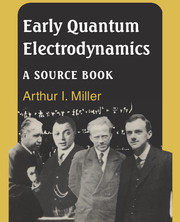Book contents
- Frontmatter
- Contents
- Preface
- Notes to the Preface
- Acknowledgements
- Notes to the Reader
- I Frame-setting essay
- 1 From quantum mechanics toward quantum electrodynamics
- 2 Second quantization
- 3 Photons and relativistic electrons
- 4 Quantum electrodynamics
- 5 Theories of the nuclear force in the 1930s
- Epilogue
- Notes
- References to the Frame-setting essay
- II Selected papers
- Index to Frame-setting essay
1 - From quantum mechanics toward quantum electrodynamics
Published online by Cambridge University Press: 05 August 2012
- Frontmatter
- Contents
- Preface
- Notes to the Preface
- Acknowledgements
- Notes to the Reader
- I Frame-setting essay
- 1 From quantum mechanics toward quantum electrodynamics
- 2 Second quantization
- 3 Photons and relativistic electrons
- 4 Quantum electrodynamics
- 5 Theories of the nuclear force in the 1930s
- Epilogue
- Notes
- References to the Frame-setting essay
- II Selected papers
- Index to Frame-setting essay
Summary
Prior to and into the first decade of Niels Bohr's 1913 atomic theory, physicists dealt with physical systems in which the usual space and time pictures of classical physics were assumed trustworthy and so could be extrapolated to any sort of matter in motion, for example, electrons move like billiard balls and light behaves analogously to water waves. In the German scientific milieu this visual imagery was accorded a reality status higher than viewing merely with the senses and was referred to as ‘ordinary intuition [gewöhnliche Anschauung]’. Ordinary intuition is the visual imagery abstracted from phenomena that we have actually witnessed in the world of sense perceptions. The concept of ordinary intuition was much debated during 1923–27 by physicists like Niels Bohr, Werner Heisenberg, Wolfgang Pauli and Erwin Schrödinger, all of whom used this term with proper Kantian overtones, and all of whom lamented its loss in the new quantum mechanics.
Ordinary intuition is associated with the strong causality of classical mechanics. According to the law of causality, initial conditions (position and velocity or momentum and energy) can be ascertained with in-principle perfect accuracy. Consequently any system's continuous development in space and time can be traced with in-principle perfect accuracy using Newton's laws of motion and conservation of energy and momentum. Any limitations to the accuracy of measurements are assumed not to be intrinsic to the phenomena, that is they are interpreted to be systematic measurement errors that ideally can be made to vanish.
- Type
- Chapter
- Information
- Early Quantum ElectrodynamicsA Sourcebook, pp. 3 - 17Publisher: Cambridge University PressPrint publication year: 1994



